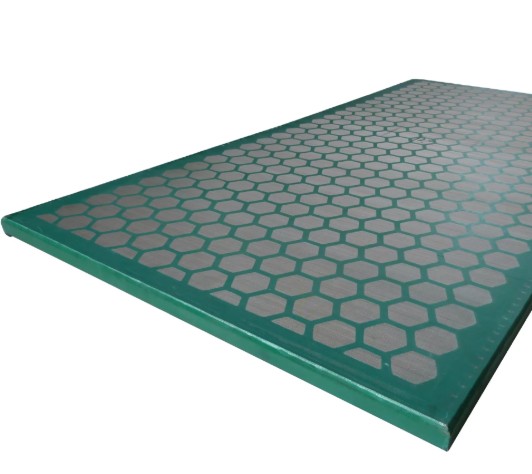In oil and gas drilling operations, shale shakers serve as the first line of defense in solids control. Their performance directly affects the cleanliness of drilling fluids, which in turn impacts drilling efficiency, cost, and equipment lifespan.
But when it comes to shale shaker screens, “size” refers to more than just physical dimensions — it includes mesh count, API number, D100 cut point, and physical frame size. This article provides a comprehensive guide to understanding shale shaker screen specifications, selection strategies, and global brand sizing references to help you make informed decisions.
Three “Sizes” of a Shale Shaker Screen: More Than Just Width and Length
When selecting a shaker screen, focusing on a single parameter (e.g., “80 mesh”) can lead to poor matching. You must evaluate screens across three key dimensions:
1. Mesh Count (Mesh Number)
Mesh count refers to the number of wires woven per inch on the screen and directly reflects the opening size:
- Higher mesh = finer openings, better for removing smaller solids (e.g., 100 mesh has smaller openings than 80 mesh).
- Lower mesh = higher flow rate, but allows more solids to pass through.
Note: The same mesh count may yield different results depending on wire diameter and weave style. So mesh alone is not a reliable performance indicator.
2. API Screen Number (per API RP 13C Standard)
The API number is an industry-standard rating based on laboratory testing that determines screen separation performance. The core metric is the D100 cut point, the size range of particles that the screen will block 100% of the time.
| API Number | D100 Cut Point (μm) | Recommended Use |
|---|---|---|
| API 20 | 780.0 – 925.0 | Large cuttings in shallow wells |
| API 80 | 165.0 – 196.0 | General-purpose mid-depth drilling |
| API 140 | 98.0 – 116.5 | Deep wells, fine solids |
| API 200 | 69.0 – 82.5 | High-viscosity fluids, fine separation |

Benefit: Screens with the same API number provide equivalent performance regardless of manufacturer, making API ratings the most reliable selection standard.
3. Physical Dimensions (Length × Width)
Screens must physically match your shale shaker model:
- Different shaker brands require precise screen sizes (e.g., MI-Swaco Mongoose: 585×1165 mm; Derrick FLC500: 695×1050 mm).
- Frame type and attachment method also vary (hook strip, pin mount, etc.).
- Improper sizing can cause leakage, installation failure, or equipment damage.
How to Select the Right Shale Shaker Screen?
1. Match API Rating to Drilling Conditions
- Deep wells / fine formations: Use higher API numbers (API 140–200) to remove fine cuttings and protect downstream equipment.
- Shallow wells / coarse formations: Use lower API screens (API 20–80) for better flow and less clogging.
- High-viscosity mud: Use mid-range screens (API 100) to balance flow rate and filtration efficiency.
2. Ensure Compatibility with Shale Shaker Model
Each shaker brand and series has specific screen dimensions and frame types:
| Brand / Series | Model Example | Screen Size (mm) | Frame Type | Typical Use Case |
|---|---|---|---|---|
| MI-Swaco | Mongoose | 585×1165 | Composite / Steel | High-capacity mid-deep drilling |
| Derrick | FLC500 | 695×1050 | Flat / Pyramid | Fine screening for deep wells |
| NOV Brandt | Cobra | 635×1250 | Composite / Steel | Land rigs with multi-phase drilling |
| FSI (Fluid Systems) | 29×42 | 737×1067 | Composite | Budget-friendly land rig operations |
| Vortex | Vortex Screen | 610×1175 | Steel Frame | Cost-sensitive drilling projects |
| Elgin / Kemtron | KPT 28 | 715×1250 | Steel / Composite | North America & Middle East drilling |
Tip: Always provide shaker brand and model, or a used screen sample when ordering replacements to ensure perfect fit.
3. Avoid the “Finer is Always Better” Mistake
- Finer screens (e.g., API 200) trap more particles but are prone to clogging with heavy mud or large cuttings.
- Coarser screens (e.g., API 20) improve flow but let more solids pass, increasing wear on downstream equipment (desanders, centrifuges, etc.).
Best Strategy:
- Use coarse screens (API 60–80) during early drilling stages to handle large cuttings.
- Switch to finer screens (API 140–200) in later stages to remove fine solids and protect fluid quality.
Summary: Key Selection Principles
- Start with API rating: Focus on D100 cut point for filtration precision.
- Check screen dimensions: Must match the shaker’s model and design exactly.
- Adjust based on drilling phase: Choose screens dynamically according to formation and fluid behavior.
With smart screen selection, shale shakers can maximize solids removal, reduce fluid loss, and improve the overall efficiency and safety of oil and gas drilling operations.